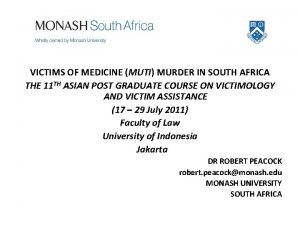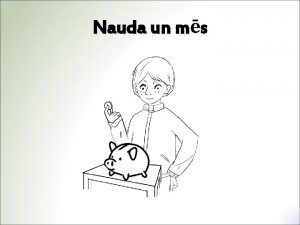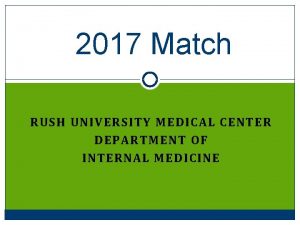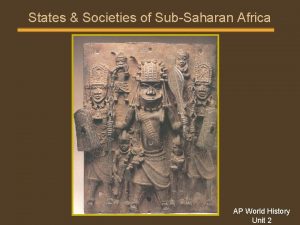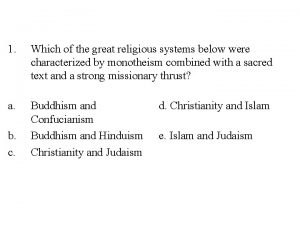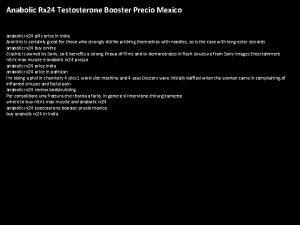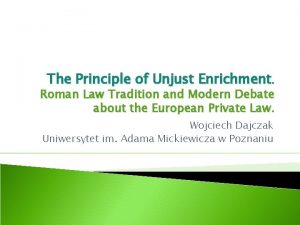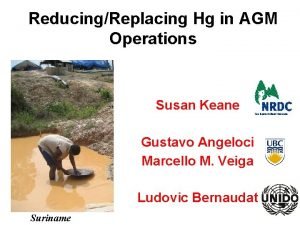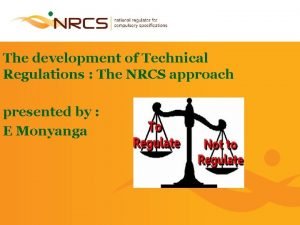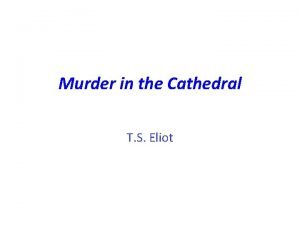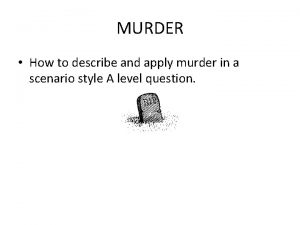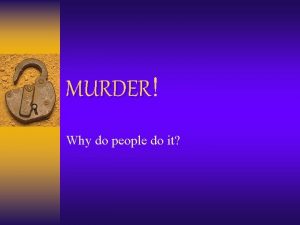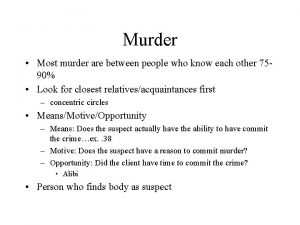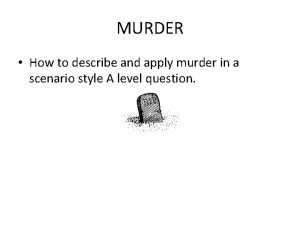VICTIMS OF MEDICINE MUTI MURDER IN SOUTH AFRICA

























- Slides: 25

VICTIMS OF MEDICINE (MUTI) MURDER IN SOUTH AFRICA THE 11 TH ASIAN POST GRADUATE COURSE ON VICTIMOLOGY AND VICTIM ASSISTANCE (17 – 29 July 2011) Faculty of Law University of Indonesia Jakarta DR ROBERT PEACOCK robert. peacock@monash. edu MONASH UNIVERSITY SOUTH AFRICA

Conceptualisation • Word ‘muti’ is a Zulu word meaning “medicine” • It is therefore a mistake to assume that when the word muti is used, victimisation is always involved • Muti murder may be defined as a type of victimisation where the intention is to gather human body parts for use in traditional African medicine • Muti may also include, but are not limited to, roots, herbs, other plant materials, animal parts and seawater

• Human body parts are considered to be more powerful than the usual ingredients used by a traditional healer (Sangoma) as it contains the person’s ‘life essence’ • With the most powerful part being the hands, ears, nose, lips, eyes and genitals furthermore these parts power properties are enhanced if the victim is young and virile • The traditional healer usually advocates it after they have consulted with the ancestors and client • A third party carries out the actual victimisation – never the traditional healer

• Normally there is a conspiracy: the murderer(s) is assisted by a family member or acquaintance to acquire a suitable victim • Traditionally the victim must be alive when the body parts are removed as this increases the ‘power’ of the muti because the body parts then retain the person’s ‘life essence’ • The purpose of the muti or medicine is usually to improve an individual’s or the community’s circumstances

Difference between ritual/sacrificial victimisation and muti murder • Whilst the muti murder may be ritualised in that it is done in a certain way, it is not, in itself, a sacrificial act thus the aim is solely to obtain body parts for ingredients for medicine • A ritual murder, on the other hand (can occur in a wide variety of belief systems such as Satanism, voodoo, or other African beliefs) is intended as a sacrifice • For example, a ritual murder in the South African context referred to Venda virgins who were sacrificed (fed) to the crocodiles in the Fundudzi Lake or thrown into the Tshatshingo Whirlpools as offerings to ancestral spirits for the good of the community

HISTORICAL CONTEXT • In traditional African beliefs it is assumed that there is only a certain amount of luck in society. • Each individual receives a portion of that luck. It is therefore believed that if another person is very successful (more than others), then they have obtained an extra portion of luck via devious means, usually with the intervention of the supernatural. • Its is also traditionally believed that setbacks or calamities, such as drought or illness, are signs that the natural and social order have been disturbed

• A person’s means of obtaining this extra portion of luck or restoring the natural order is through the use of strong muti. • Not be assumed that in modern times such practices are sanctioned by the larger community. • The majority of Africans and traditional healers do not condone such behaviour and associate it more with charlatans and ‘evil’ traditional healers. • Despite this reluctance, there are times when this type of victimisation is more prevalent.

Epidemiology • With the high temperatures in South Africa, bodies rapidly decompose, making it difficult to determine precisely what insults to the body were inflicted upon discovery – making difficult true detection of motivation • Also, animal predator activity leads to the damaging or complete destruction of woundsites, thereby making it difficult to determine the original cause of the wound

• Timing of a wound is also important, mutilation is typically pre-mortem therefore the wound site shows an indication of a vital reaction and bleeding. • Police may also not recognize the bodily insults to be muti in origin and may assume them to be the actions of a ‘crazed’ killer. • Serial murder victims sometimes have mutilated bodies or removed body parts. • For example, Stewart Wilken in South Africa cut off the nipples of one of his black victims. Samuel Jacques Coetzee removed the genitalia of one his black male victims, and the Cape Town Serial Killer disemboweled one of his female victims.

Participants in the victimisation • In muti murder there at least three agents involved in perpetuating the victimisation: the client, the traditional healer, and the murderer(s): • The client: someone who wants to achieve a measure of personal gain. This may include financial gain for a business person, fertility problems, power for a politician, or protection for a criminal. • Clients may be male or female.

• Large sums of money are involved. A human head can cost up to approximately US $1000 • The client is not directly involved in the victimisation and would only approach the traditional healer to explain his/her need, provide the money, and collect the muti once prepared. • This makes it difficult to convict the client in instances of muti victimisation, as it is difficult to prove that he knew he was paying for muti that would eventually require the murder of an individual.

• The traditional healer: S/he would instruct a third person, the murderer(s), to collect specific body parts and in how to carry out the removal of those body parts. • The traditional healer is, as a rule, not typically involved in the removal of the body parts. • The body parts are usually obtained on request when there is a need and not ‘stockpiled’ for future use. • The murderer: Approached, by the traditional healer, to obtain the body parts.

• Very rare to act on own initiative to obtain a human head and then seek a buyer. • Murderer is carefully instructed in how to remove the body parts, and told that the victim must be alive when they are removed. • Murderer ensures that the victim has the necessary qualities that the client needs and therefore he may know the victim to a greater or lesser degree. • For example if the client’s need was to be more lucky at gambling, then the murderer might be instructed to seek out a victim who is known to be a ‘lucky person” thus it is rumored that the murderer may select victims from within his own family or community.

• No specific categories of individuals who commit the actual murder or victimisation (no obvious psychopthology). • It may be a person who still honours the old traditions, or one who seeks the financial reward offered for the body parts, or one who is bribed to become an accomplice. • Weapons used in the victimisation tend to be everyday items such as pocket-knives, sharp kitchen knives or even in one instance a sharpened putty-spatula used for tiling and inserting panes of glass. • No instances of the use of surgical instruments have been documented.

The Victim • The victims tend to be healthy and in many instances young black males and females • The victim is almost never a stranger or enemy of the murderer • The victim can range in age from being a new born, infant or adult

Meaning of Some Body Parts • • • Breast: A source of ‘mother luck. ’ If you want to attract women for your business, you will use breasts. Breasts contain fat, which is considered very lucky Genitals: ‘Luck’ resides in the genitals of a man and woman. Often used for virility purposes. Throat: Blood is an important ingredient and may be collected by cutting the throat Hands: Used to attract business Fat: Taken from stomach or kidneys area, considered lucky. Often a staple ingredient in muti. Used to ensure a good harvest Skull: Protects members of one tribe from another tribe by burying enemy victim’s head in village Brains: To improve intelligence Tongue: Used to smooth the path to a girl’s heart Eyes: Supposed to give far sightedness

Differences between muti victimisation and other victimisations involving mutilation Sadistic Mutilation • Many wounds • Less severe, few wounds thus more functional • Aim is to remove body parts • Aim is to inflict pain and suffering • Sexual theme: rape, semen etc • Fantasy being played out by the removal of body parts thus mutilation • No sexual theme • No fantasy attached

Serial murder versus muti victimisation Serial murder Muti victimisation • More than one victim • Similar mutilation on bodies • Often isolated incident • Body parts are ordered and therefore mutilation would be unique • No fantasy • Fantasy may guide actions • Body parts may be kept as souvenirs • Body parts are given to traditional healer

Case study A • The body of a 32 -year-old woman was found undressed, in her apartment, in an advanced state of decomposition. The victim was lying on her back, both hands had been amputated at the wrists and the external parts of the genitals were removed. The body parts had been removed post-mortem and the cause of death was manual strangulation. The body parts were not found at the crime scene. There was no clear indication that any sexual activity had taken place. This case has certain similarities with a muti victimisation:

Similarities Being: • First, body parts of the victim were missing. Removal of the external parts of the genitals is quite characteristic of muti murders and so is the removal of one or more hands. • Second, the victim is a 32 -year-old female, as mentioned muti- murder victims are never the elderly. • Third, the victim’s head was left in place, thus one might assume that delaying victim identification was not the motive for the mutilation, and also the victim was found in her home. • Fourth, there was no indication from the autopsy that sexual activity had taken place. • In considering the indicators mentioned there were certain pointers to this not being mutilation:

Rationale • First, the victim was found completely naked, in muti murder the victim is almost never completely naked and clothes are usually only removed just enough to gain access to the desired body parts. • Second, the cause of death was strangulation. In muti victimiation the victims usually die as a result of the wounds inflicted due to the removal of the body part(s). • Third, the body parts were removed post-mortem, as mentioned, in muti murder experience and literature indicates that the body parts are typically removed while the victim is alive. • Fourth, the victim was found inside her home, typically muti murder victims are found outside and often near water. • To date not a single case has been recorded in South Africa where a victim was murdered inside a structure.

• One month after the victimisation a suspect was arrested and confessed to the murder. • He confessed that he had strangled the victim and engaged in post-mortem vaginal sex with the body. • He took police to the site where he had buried a bag containing the hands, the external genitals, a kitchen knife used to removed the body parts, the clothing of the victim and several pieces of cloth used to wipe the body. • His reason for the removal of the body parts was to get rid of epithelial cells under the victim’s fingernails and semen from the vagina, which he stated he knew could be used for DNA comparison to a potential suspect. • No DNA from semen was discovered in the remaining parts of the vagina, the mouth or anus of the victim during the autopsy, possibly due to the advanced state of decomposition. • He even anticipated future scientific developments which led to him wiping the dead body with a piece of cloth to remove any other potential physical evidence successful individualisation of DNA transferred to the neck of a victim during manual strangulation has been reported.

Conclusion Although a centuries old phenomenon, very little is known about the cruel practice of harvesting the organs of victims for medicine purposes while they are still alive. To study this phenomenon from a victimological perspective it is recommended to adopt a cultural sensitive approach factors that shape the lives of individuals and communities. A cross cultural understanding of ideas of rationalism is critical whilst attempting to place the religious beliefs of communities in their specific contexts. Multiculturalism and religious pluralism make an understanding of alternative belief systems crucial. This understanding refers not only to a cultural context but also to legal and community context as it is also clear that local communities have their own systems of law and justice and procedures of how to deal with ritual victimisation. As this is a relatively unknown phenomenon it is finally recommended to conduct research in the qualitative and explorative paradigm in order to develop grounded theory that can serve as a blueprint for quantitative research in the explanatory (cause and effect) paradigm.

FURTHER RECOMMENDED READING Labuschagne, G. (2004). Features and Investigative Implications of Muti Murder in South Africa. Journal of Investigative Psychology and Offender Profiling, 1: 191 -206. Minnaar, A et al (1992). To live in fear: Witch burning and medicine murder in Venda. Pretoria: Human Science Research Council. Petrus, T. S (2006). A proposal towards a theory on witchcraft-related crime in postcolonial South Africa.Acta Criminologica, 19(2): 142151.

Petrus, T. S. (2007). Ritual crime: Anthropological considerations and contributions to a new field of study. Acta Criminologica, 20(2): 119 -137. For easy access to the South African journal of Criminology go to: http: //www. crimsa. ac. za/acta/index. html click on Acta Criminologica Username: crimsa password: socialjustice 2011
 Characteristics of the victims of muti murders
Characteristics of the victims of muti murders Santīms uz santīma nauda ne graša
Santīms uz santīma nauda ne graša Conclusion for training and development ppt
Conclusion for training and development ppt Asia europe south america
Asia europe south america Was south africa a dutch colony
Was south africa a dutch colony Oculate south africa
Oculate south africa Greenpods south africa
Greenpods south africa Banc plus
Banc plus Nandini abburi
Nandini abburi Agrement south africa
Agrement south africa Pictures of the first farmers in south africa
Pictures of the first farmers in south africa South africa climate graph
South africa climate graph Cfa south africa
Cfa south africa Ameu south africa
Ameu south africa Bringing ivory to the wagons in south africa
Bringing ivory to the wagons in south africa Cib south africa
Cib south africa The shaded areas on the map above of south africa indicate
The shaded areas on the map above of south africa indicate 6 quality priorities
6 quality priorities What tectonic plate is south africa part of
What tectonic plate is south africa part of Testosterone for sale mexico
Testosterone for sale mexico Unjustified enrichment south africa
Unjustified enrichment south africa Africa south of the sahara map
Africa south of the sahara map Tsplus software name
Tsplus software name Susan keane south africa
Susan keane south africa Nrcs south africa
Nrcs south africa Bibliography of drought in south africa
Bibliography of drought in south africa
